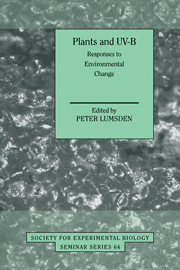Book contents
- Frontmatter
- Contents
- List of contributors
- Preface
- PART I The ozone layer and UV-B radiation
- PART II Effects of UV-B on plants at the cellular level
- DNA damage and repair in plants
- Genetic analysis of DNA repair in plants
- Photosynthesis and photoinhibition
- UV-B effects on the expression of genes encoding proteins involved in photosynthesis
- UV-B perception and signal transduction
- Ultraviolet radiation as a stress factor and the role of protective pigments
- PART III Effects of UV-B at the whole plant and community level
- Index
UV-B perception and signal transduction
Published online by Cambridge University Press: 04 August 2010
- Frontmatter
- Contents
- List of contributors
- Preface
- PART I The ozone layer and UV-B radiation
- PART II Effects of UV-B on plants at the cellular level
- DNA damage and repair in plants
- Genetic analysis of DNA repair in plants
- Photosynthesis and photoinhibition
- UV-B effects on the expression of genes encoding proteins involved in photosynthesis
- UV-B perception and signal transduction
- Ultraviolet radiation as a stress factor and the role of protective pigments
- PART III Effects of UV-B at the whole plant and community level
- Index
Summary
Introduction
Plant growth and development are regulated by aspects of the environment throughout the life cycle. Plants continually gather information about a wide range of environmental variables which elicit particular responses. Such environmental factors function as cues to initiate developmental transitions, for instance, in the photoperiodic induction of flowering observed in many plant species. However, environmental signals may also be potentially harmful and the plant's response is then to minimise damage. Examples of abiotic environmental stresses include drought, extremes of temperature and UV-B irradiation, the subject of this volume.
Although responses to external signals, such as UV-B radiation, may be studied at the whole plant level, the signals are perceived and responded to at the cellular level. In addition to external signals, plant cells respond to a range of endogenous signals, such as the concentrations of metabolites and growth regulators. Thus, individual plant cells have the capacity to respond to a range of signals, which regulate their growth and differentiation and affect their survival. A key point is that cells must have mechanisms which allow signals to be detected and acted upon to give rise to particular responses. The detection of signals in many cases is likely to involve specific cellular components termed receptors. Reception is coupled to the terminal response by signal transduction mechanisms. The signal transduction process often serves to amplify the initial signal and in some cases may store it for periods of time.
- Type
- Chapter
- Information
- Plants and UV-BResponses to Environmental Change, pp. 135 - 156Publisher: Cambridge University PressPrint publication year: 1997
- 19
- Cited by

